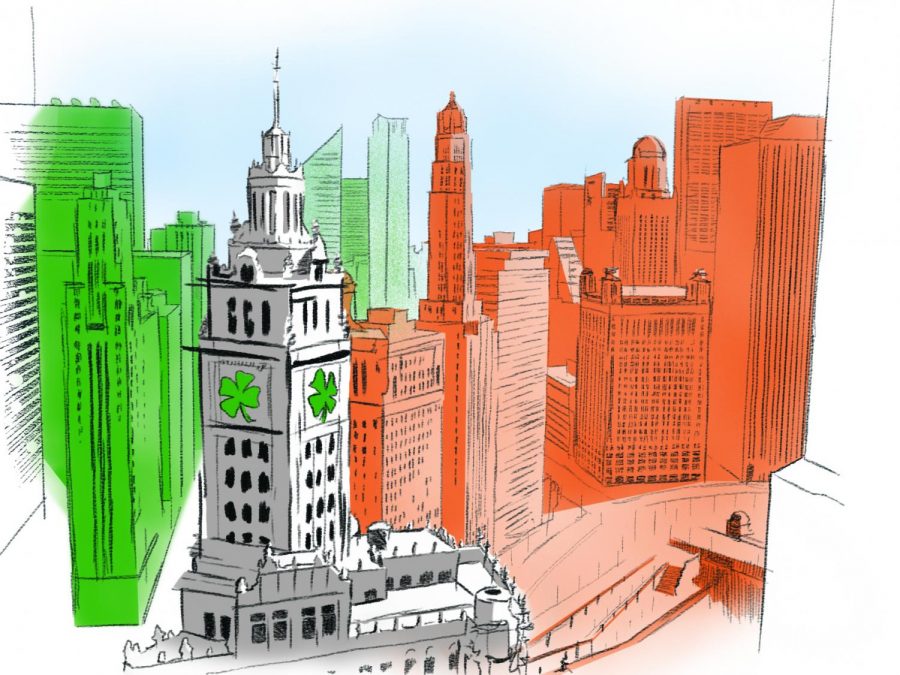Irish-American culture comes alive on St. Paddy’s Day
St. Patrick’s Day in Chicago
March 17, 2014
The Chicago River is green once again, and even though the parade is over, the weekend’s celebrations are still going strong. A pub crawl could make for a night of adven- ture, but experiencing traditional Irish music, dance and fine art all while holding a tall glass of Guin- ness will tantalize senses in a different way.
The Irish American Heritage Center, 4626 N. Knox Ave, is host- ing its three-day St. Patrick’s Day celebration which ends Monday and includes traditional Celtic mu- sic, dance performances, geneol- ogy sessions, museum exhibits and art exhibits. March 17’s festivities will be held in the Irish American Heritage Center pub and lounge.
About 1,000 Irish Americans and non-Irish Americans come to the center to celebrate St. Pat- rick’s Day, said Kathy O’Neill, the center’s public relations manager. The center was founded in 1985 as both a place for Irish immigrants to feel welcome and as a place for non-Irish Americans to learn about the culture. While the center often hosts educational, family- friendly classes and exhibits, it also encourages adult activity with its traditional Irish pub. O’Neill said it is a great time to become immersed in the culture.
“We’ll go through a lot of Guinness,” O’Neill said. “[Guests] can also go into our art galleries. It’s a great way to celebrate what it means to be Irish.”
Irish immigrants went from the Great Potato Famine and British oppression from a disorganized socio-economic system in their native country to finding good jobs and overcoming prejudice in the U.S., said Irish immigrant and music instructor at the Irish American Heritage Center Noel Rice. Coming to America, Irish immigrants brought a new way to celebrate the traditional religious holiday of St. Patrick’s Day with them, Rice said. The Republic of Ireland became independent from England in 1916 but was not recognized until 1922, at which point St. Patrick’s Day became a source of pride and independence for the Irish.
Rice said the cultural significance of St. Patrick’s Day is now lost on most Americans, who instead see it as an excuse to party. However, Rice added that he embraces all forms of American St. Patrick’s Day celebrations because this spirit originated from Irish pride. He said he thinks non-Irish Americans can benefit from visiting and taking classes at the center. St. Patrick’s Day is a good chance for non-Irish Americans and Irish Americans alike to celebrate, Rice said.
Rice said he started teaching at the center because he wanted his children to learn to play Irish music but could not find classes that emphasized it. Marian Ryan, general manger of Chicago Gaelic Park, an- other Irish cultural center in Chicago, said it is important to preserve culture because it helps people understand who they are. Ryan under- stands the American cultural significance of St. Patrick’s Day as well as the traditional Irish meaning and the modern Irish meaning. St. Pat- rick’s Day’s meaning has changed in America, but Ryan, an Irish native, said St. Patrick’s Day has changed in Ireland as well.
In Ireland, [St. Patrick’s Day] has always been a religious holiday,” Ryan said. “You would get up and go to mass and participate in the local parade and that would be it. Now it’s completely different. It’s very much like here—It’s a day that everyone is out celebrating. It’s just taken on a whole life of its own.”
Rice said he thinks St. Patrick’s Day became such a popular holiday in America because immigrants like himself have a deep Irish pride.
“Coming from that background to the most successful ethnic group, you would kind of sense that in the kind of pride or almost aggressive pride in the St. Patrick’s Day thing,” Rice said. “That continues today; we still have that exuberance or almost triumphalism.”
The Irish American Heritage Center highlights Irish culture with that same energy all year long, not just on St. Patrick’s Day, and Rice said he thinks the center is important to first generation Irish immi- grants and generations beyond.
“If you lose some of those connections or contacts with the past, then you become free-floating and who knows what you might be- come,” Rice said. “American, may- be,” he added with a chuckle.








